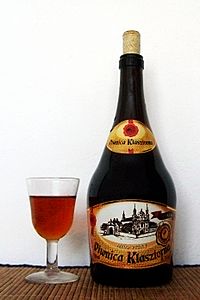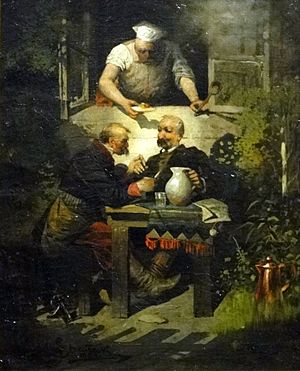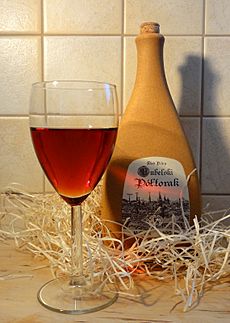Mead in Poland facts for kids

A bottle and a glass of trójniak mead
|
|
| Type | Mead |
|---|---|
| Country of origin | Poland |
| Introduced | Middle Ages |
| Alcohol by volume | 9–18% |
| Colour | Golden to dark amber |
| Flavour | Honey |
| Ingredients | Honey, water |
| Variants | Fruit, herbal, spiced |
Mead, called miód pitny in Polish (which means "drinkable honey"), is a special drink from Poland. It's made by fermenting a mix of honey and water. This process uses yeast to turn the sugar in honey into alcohol.
Mead smells and tastes like honey. Sometimes, fruit juices, herbs, or spices are added to make it even more interesting. Its color can be golden or dark amber, depending on the type of honey used.
In 2008, the European Union officially recognized four traditional Polish mead types as a "guaranteed traditional specialty." This helped Poland become the world's biggest producer of mead made the old-fashioned way.
Types of Polish Mead
Polish mead comes in four main types: czwórniak, trójniak, dwójniak, and półtorak. These names tell you how much honey and water are used to make them. The name comes from the total number of parts. For example, czwórniak is made from one part honey and three parts water, making a total of four parts.
The less water used, the stronger, sweeter, and more expensive the mead will be.
| Type | Honey-to-water ratio | Alcohol content | Sweetness | Minimum aging time |
|---|---|---|---|---|
| Czwórniak | 1 part honey : 3 parts water | 9–12% | Dry (not sweet) | 9 months |
| Trójniak | 1 part honey : 2 parts water | 12–15% | Semi-sweet | 1 year |
| Dwójniak | 1 part honey : 1 part water | 15–18% | Sweet | 2 years |
| Półtorak | 2 parts honey : 1 part water | 15–18% | Very sweet (dessert) | 3 years |
Mead can also be flavored in different ways:
- Fruit mead (miód owocowy): Made with fruit juices.
- Herbal mead (miód ziołowy): Made with herbs.
- Spiced mead (miód korzenny): Made with spices.
Some traditional flavors include:
- agrestniak: with gooseberry juice
- borówczak: with lingonberry juice
- czereśniak: with sweet cherry juice
- czerniak: with bilberry juice
- dębniak: aged in oak barrels
- dereniak: with Cornelian cherry juice
- gruszeczniak: with pear juice
- jabłczak: with apple juice
- jarzębiak: with rowanberry juice
- jeżyniak: with blackberry juice
- kaliniak: with guelder rose juice
- lipiec: made from linden honey
- maliniak: with raspberry juice
- miód chmielowy: with hops
- miód gronowy: with grape juice
- morwiak: with mulberry juice
- porzeczniak: with currant juice
- poziomczak: with woodland strawberry juice
- śliwniak: with plum juice
- wiśniak: with sour cherry juice
Other popular ingredients for flavor include celery leaves, cinnamon, cloves, elderberries, ginger, juniper berries, rose oil, and vanilla.
How Mead is Made
Mead is made by fermenting a mixture of honey and water, called "must." The amount of honey and water depends on the type of mead being made. For very sweet meads like dwójniak and półtorak, some honey is added later in the process. This is because too much sugar at the start would make it hard for the yeast to work.
For fruit meads, at least 30% of the water is replaced with fruit juice. Herbs or spices can also be added at this stage.
In factories, the must is usually boiled at a high temperature (95–105 °C). This is called miód sycony (saturated mead). Boiling helps prevent the sugars from turning into caramel. Some mead, especially homemade, is made without boiling the must. This is called miód niesycony (unsaturated mead) and keeps more of the honey's natural smell.
After boiling, the must is cooled quickly to about 20–22 °C. This is the best temperature for the yeast to grow. Then, yeast is added to the must in a special tank. The first part of fermentation is very active and lasts about 6–10 days. After this, a quieter fermentation takes place for 3–6 weeks. During this time, any remaining honey can be added for dwójniak or półtorak.
Once the mead has enough alcohol (at least 12%), it is moved to another container to age. Aging helps the mead develop its flavor and quality. This process can involve filtering and pasteurizing (heating to kill germs).
Finally, honey, herbs, spices, or a little more alcohol can be added to adjust the flavor. The mead is then bottled, often in traditional carboys, ceramic bottles, or oak barrels.
How to Enjoy Mead
In Poland, mead is usually served at room temperature in a glass or a stoneware cup. Depending on the weather, it can also be enjoyed chilled (around 12°C) or warm.
On a hot day, chilled mead can be served with mint or a lemon slice. In winter, many Poles enjoy warm, mulled mead. This warm mead might have extra flavors like cloves, cinnamon, vanilla, ginger, black pepper, or a slice of orange.
A Look Back: Mead's History

Making and drinking mead in Poland is a tradition that goes back many centuries. In the Middle Ages, Poland had huge forests that were full of honey. Because of this abundance of honey and a climate not good for growing grapes, mead was more popular than wine for a long time.
In 996, a traveler named Ibrahim ibn Yaqub wrote that the country of Mieszko I (an early Polish ruler) had lots of mead. In the 15th century, a diplomat from Venice named Ambrogio Contarini noted that Poles "make a certain drink out of honey, which intoxicates people much more than wine."
A Polish poet from the 16th century, Sebastian Klonowic, even called mead a "nectar" fit for the gods, saying:
Wine comes from the earth muddy and grey,
Mead must be sent down straight from the heavens.
Even though mead was very popular, it was always a special, expensive drink. It was saved for big events like weddings and only richer people could afford it. Beer was the everyday drink for most people. Mead was so valuable that it was given as a gift to monasteries and important people.
The oldest known recipe for mead was written down in 1567 by a Swedish historian, Olaus Magnus. He got the recipe from someone in the Polish city of Gniezno. In the 17th century, Polish mead was flavored with things like fennel, pepper, cloves, cinnamon, anise, poppy seeds, or parsley. The names for the different types of mead (czwórniak, trójniak, dwójniak, and półtorak) also come from this time.
Around the 17th century, mead started to become less popular. People began to prefer wine imported from other countries, especially Hungary, and also vodka made in Poland. By the 19th century, mead was seen as a reminder of old Poland, appearing in famous Polish stories and poems like Pan Tadeusz by Adam Mickiewicz.


